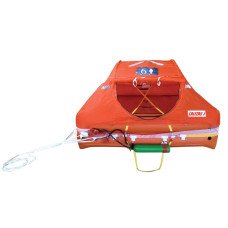Liferafts — Reliable Life-Saving Equipment for Every Voyage
A liferaft is the ultimate life-saving system on board — when everything else fails, it must perform flawlessly.
At Gaelix Marine Service, as an official distributor of LALIZAS, we offer a full range of certified liferafts for all applications: commercial ships, passenger vessels, offshore operators, and pleasure craft.
Choose from our selection of ISO, SOLAS, and Coastal Liferafts — all fully compliant, quality-tested, and available at the best prices with immediate stock.
Complete Range of Liferafts by LALIZAS
✅ ISO Liferafts — for Offshore & Racing
-
ISO ATLANTIC Liferafts (less than / more than 24h)
-
ISO RACING II Liferafts — ultra-light for competitive sailing
-
EUROPE II INSHORE Liferafts — compact & ideal for short-range cruising
✅ Coastal Liferafts
-
COASTAL COMPACT — ideal for coastal cruising & smaller boats
✅ SOLAS Liferafts — for Merchant & Passenger Vessels
-
SOLAS OCEANO — Throw-overboard / Davit-launched / Self-righting types
-
Open reversible, throw-overboard, and davit models available to meet vessel requirements and capacity needs
✅ LifeLink Evacuation Liferaft — fast deployment for emergency evacuations
✅ SEAWORLD Liferafts — versatile & reliable solutions for a variety of commercial vessels
Why Choose Liferafts from Gaelix Marine Service?
✅ Official Distributor of LALIZAS — all liferafts supplied with full certification & traceability
✅ Stock availability — fast dispatch across Europe & worldwide
✅ Expert guidance — we help you select the right model and configuration for your vessel & flag state requirements
✅ Competitive prices — excellent value with official support & service
✅ After-sales support — inspection and servicing options available
Which Liferaft Do You Need?
Choosing the right liferaft depends on:
✔ Vessel type (commercial, passenger, offshore, yacht)
✔ Required certification (ISO, SOLAS, National regulations)
✔ Expected time to rescue (less than 24h, more than 24h)
✔ Deployment type (Throw-overboard / Davit-launched / Self-righting)
✔ Capacity needed
Our team at Gaelix Marine Service is ready to assist you in selecting the most suitable liferaft for your needs. Contact us today for professional advice.
Stay Safe — Be Prepared with a Certified Liferaft
When an emergency happens at sea, there is no room for compromise.
Invest in a certified LALIZAS liferaft from Gaelix Marine Service — and equip your vessel to meet all safety requirements with complete peace of mind.
✅ Merchant fleets
✅ Offshore oil & gas platforms
✅ Passenger vessels & ferries
✅ Fishing boats
✅ Yachting & racing yachts
Shop online now at Gaelix Marine Service — your trusted partner for marine life-saving equipment.




-100x100.png)































